2013 Arctic Cat Sno Pro 500 vs. 2013 Yamaha Phazer RTX

Two truly fun play sleds for beginners or experts
At first glance the Arctic Cat Sno Pro 500 and Yamaha Phazer RTX seem worlds apart. When you go in close, you realize that these two snowmobiles, while different in so many ways, end up in the same place. They are incredibly fun to ride. Indeed, each almost invites you to throw a leg over the saddle and grip the bars in anticipation of a very spirited day of riding.
Make no mistake; with barely 80 horsepower on tap, neither sled will throw you back the length of the seat if you slammed the throttle to the bar. The Arctic Cat might respond a bit quicker, the difference between its two-stroke breeding and the high-revving spooling of the Yamaha four-stroke. These are two quite sophisticated designs with engineering that came from different places to result in a similar end point.
The Arctic Cat Sno Pro 500 seems a bit dated now. Its chassis and front suspension design prefaced the new-for-2012 ProCross. The Sno Pro 500 borrowed from the race sled of the time, a sled that could run snocross as well as compete in cross-country real-world terrain events. This sled came into being as a racing throwback to Team Arctic aspirations of the past. It was to be the foundation for future Arctic Cat racers. It would be the sled that took Cat wannabe racers from Kitty Cats to snocrossers. The engineering borrowed heavily from the real 600cc race sled, but costs were kept in line so that Arctic Cat dealers could retail the sled to budget-strapped racers.
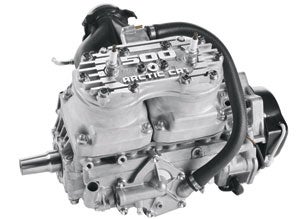 The clean version of the Sno Pro 500’s Suzuki-built 500cc twin delivered 20-horsepower less than the older and dirty version.
The clean version of the Sno Pro 500’s Suzuki-built 500cc twin delivered 20-horsepower less than the older and dirty version.To fit into appropriate horsepower racing categories, the Sno Pro recycled the same Suzuki 500cc two-stroke that powered Arctic Cat’s F5. That twin cylinder powerplant had come in two iterations, one that shoved more than 100 horsepower to the track and a more docile, but cleaner burning version of 80-plus horsepower. Ahh, how we longed for the dirty twin in the Sno Pro 500. The Sno Pro 500 was okay, but it could have been so much more fun with the EPA-rejected higher horsepower engine.
When the Sno Pro 500 took to the snows, it did so in protected numbers. Arctic Cat marketing intended it as the boy racer and wasn’t making much profit on each one sold, so the volume was low. But enough to feed Arctic Cat racing wannabes. And enough to attack and conquer an unexpected threat from Yamaha.
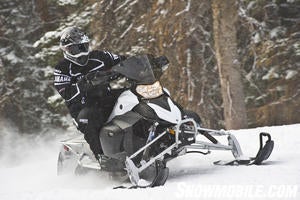 Yamaha fit premium gas shocks to control the Phazer’s suspensions, front and rear.
Yamaha fit premium gas shocks to control the Phazer’s suspensions, front and rear.
Cross country racers looked at the Yamaha Phazer RTX as an alternative to the 55-plus horsepower, fan-cooled sleds that competed in the lower levels of terrain racing. The Phazer’s four-stroke powerplant qualified to run against the fan-cooled, two-stroke likes of the Ski-Doo MXZ 550, Arctic Cat F570 and Polaris’ various 550cc fan-cooled models. With 80 to 85 horsepower the Phazer proved a nice alternative. The engine sat way back in the chassis. The engine utilized a very sophisticated electronic fuel injection system that delivered impressively precise throttle action. Based on Yamaha’s world-class dirt bike engines, the new Genesis twin needed an Apex-like gear reduction to bring top end revs from 12,000 to those manageable for conventional constant velocity transmissions. The Phazer twin shifts out at more than 11,000 rpm without taking into the account the reduction, which brings initial engagement to fewer than 4100 revs.
With the added power and the rough trail engineering built into the Phazer, it enjoyed early success in cross-country running where Yamaha’s famous quality and durability served its riders well. This was the sled that Arctic Cat sought to beat with what stood out as a detuned Team Arctic race sled.
The Sno Pro 500 bested the Phazer in terrain racing. It was equally powered. It had fuel injection. It revved hard. And it had the talents of Team Arctic’s full-fledged racer for its underpinnings. The Phazer campaigned on, but it was more trail sport sled than race sled.
With that confrontation as history, Arctic Cat and Yamaha face-off at dealerships across the snow belt. This time the advantage goes to Yamaha. Nothing against the Sno Pro 500. But what made it a successful racer works against it as a volume-selling number at dealerships. It was always a low volume model. The Phazer was designed to move bigger numbers. We expect they are more readily available. And, now that Arctic Cat has shown the world its ProCross models, that is where the demand lies, not in the pre-ProCross Sno Pro 500.
If you have the chance to score either the Sno Pro 500 or the Phazer RTX, don’t be shy. Either would be a fun choice. The Sno Pro 500 will respond more like the traditional two-stroke sled you’re used to. Where the Arctic Cat twin feels quicker off the throttle, the Yamaha four-stroke is true to its heritage that depends on high revs for power. The Yamaha will power up nicely, but there’s a bit of a turbo lag feel to it as it spools up. When cornering with either sled you want to keep the power on as performance drops off quickly when you back off the throttle.
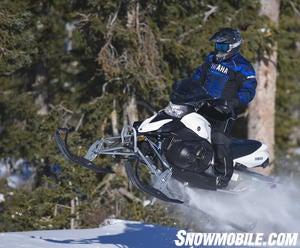 Yamaha intended for the Phazer RTX to be the snowmobile equivalent of a lightweight dirt bike.
Yamaha intended for the Phazer RTX to be the snowmobile equivalent of a lightweight dirt bike.
Both sleds utilize very good suspension components. The Yamaha attacks the snow with a double wishbone front controlled by Fox Float air shocks that handle the 8.6-inches of travel quite nicely. A little tweaking of the front-end results in a consistent cornering sled that will hold the inside line very well – as a racer would want.
The Arctic Cat Sno Pro features the later Arctic Wishbone design, the AWS VIII. Also a twin wishbone design the Arctic Cat front-end works through nearly an inch more travel. Standard Fox Zero Pro gas shocks work well, but because the Sno Pro 500 was intended to be a racer wannabe, there are many premium shock options available through Arctic Cat dealers. The rear suspension borrowed directly from the Arctic racer, giving the Sno Pro 500 13.5-inches of travel from the slide-action parallel rail design. The Sno Pro 500’s fully coupled rear end features torsion springs to fine-tune the ride. There’s a two-inch in diameter Fox shock on the rear arm.
The Yamaha’s Dual Shock CK rear suspension uses two clicker gas shocks. Like the Arctic Cat, the Phazer RTX also uses a coupled action to keep handling consistent through the suspension’s 16.2 inches of travel. The Phazer’s ride is extremely compliant and very settled even in truly nasty bumps.
While we hand the Arctic Cat Sno Pro 500 a bit of an edge in the racer performance category, we endorse the Yamaha Phazer RTX as the better all around trail sport bet. The engine and drive systems are virtual toss-ups. The Arctic Cat feels more engaged, but the little engine that could when it had the 105-horsepower output is nothing special at 82-hp. The Yamaha, even with its lagging feel, will be the better choice for the long haul in this chassis. The 500cc two-stroke Suzuki twin is at home in Arctic’s F5 chassis, but seems lacking for total sport in the Sno Pro at top end. The Yamaha winds out better at top speed, showcasing that side of its Yamaha motorcycle heritage.
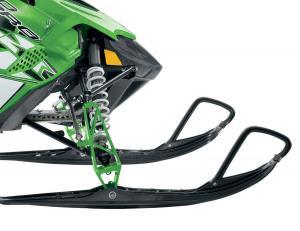 The Sno Pro 500 borrowed a version of the latest Arctic Wishbone Suspension from the race sled.
The Sno Pro 500 borrowed a version of the latest Arctic Wishbone Suspension from the race sled.
Styling-wise the Yamaha looks a bit odd when compared to the more traditional Sno Pro 500. For a full-sized guy, the Sno Pro 500 will fit better. Even though its saddle is narrow, it is wider than the Phazer. For tossing these sleds around, it’s a toss up here, too. The Phazer likes body language. The Sno Pro accepts it.
What you’ll notice on the trail is that the Phazer may seem a bit skittish and we lay that at the 14-inches of track width. The Cat track measures an inch wider and seven inches longer, at 128-inches in length.
As a sport trail rider, things to give the Yamaha an edge include expected resale and all those four-stroke advantages of less oil usage, cleaner burning, etc. Since we are spoiled with creature comforts, the electric start and push button reverse work for us in favoring the Yamaha.
But, at the end of the day, what would be ideal is having both sleds in the garage. Then we could ride with a buddy, swap sleds throughout the day and never have to choose. Because, you know what, we aren’t going to choose one over the other. This is a case where each sled has solid uncontested strengths making it impossible for us to wholeheartedly say that we strongly want one over the other. They retail within a couple hundred bucks of each other, have an insignificant horsepower difference, and are immensely fun to ride. We figure that having to settle for one over the other is not settling at all. We’d be quite happy with either.
| 2013 Arctic Cat Sno Pro 500 | 2013 Yamaha Phazer RTX | |
| Engine | Suzuki-built 499cc, liquid-cooled two-stroke with electronic fuel injection | Yamaha Genesis, 499cc liquid-cooled, twin cylinder, four-stroke; Keihin electronic fuel injection; digital ignition |
| Horsepower | 82 | 80 (claimed) |
| Drive | Arctic 6-post primary drive with TEAM driven | Yamaha YVRC |
| Front Suspension | Arctic Cat AWS VIII; Fox Zero Pro floating piston gas shocks; up to 9.5-in travel | Yamaha double A-arm with Fox Float shocks; up to 8.6-in travel |
| Rear Suspension | Coupled Race Slide-Action rear suspension; adjustable torsion springs; Fox gas shocks | Yamaha Dual Shock CK with C36 & C40 aluminum bodied gas shocks |
| Length | 117.0 in | 111.0 in |
| Width | 48.8 in | NA |
| Height | NA | 46.8 in |
| Ski Stance | 43.0 in | 42.5 in |
| Track | 15x128x1.0 HackSaw | 14x121x1.0 RipSaw |
| Brake | Axial master cylinder hydraulic with disc on driven shaft | Two-piston hydraulic brake with ventilated disc |
| Features | Standard: dual halogen headlight, low windscreen, electric fuel gauge, digital/analog gauge Optional: sport bumper, hand guards, premium shocks, various windshields, storage bags | Standard: electric start; halogen headlights; mechanical reverse; digital display Optional: DC outlet; rearview mirrors; storage bags |
| Fuel Capacity | 11.0 US Gal | 7.0 US Gal (Premium Fuel) |
| MSRP | $8,799 | $8,599 |
| Full Specs | Here | Here |
Related Reading
2012 Yamaha Phazer RTX Review
2011 Arctic Cat Sno Pro 500 Review
2013 Polaris Indy 600 vs. 2013 Ski-Doo MXZ Sport 600
Arctic Cat F570 vs. Polaris 550 Shift IQ vs. Ski-Doo MXZ TNT 550F



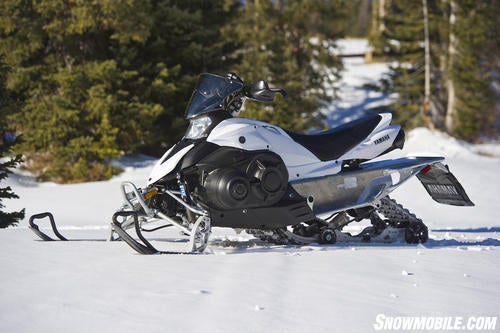
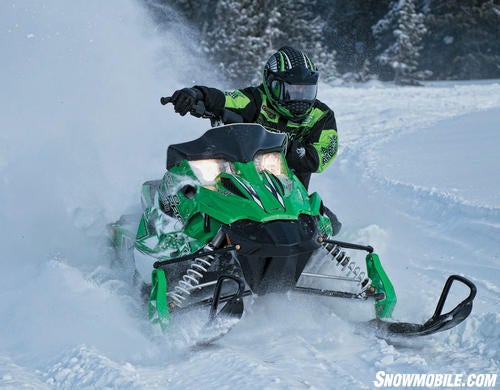





 Your Privacy Choices
Your Privacy Choices